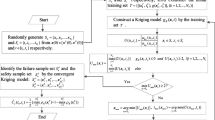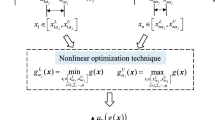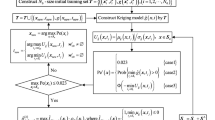Abstract
In the existing method combining adaptive Kriging and fuzzy simulation (AK–FS) for estimating the failure possibility, the AK is required to correctly identify the state of each sample point in the candidate sample pool of FS. However, the states of some sample points have no contributions to the accuracy of estimating the failure possibility, and identifying their states by the existing AK–FS only results in a loss of efficiency. Therefore, this paper proposes a new probability learning strategy to improve the efficiency of the existing AK–FS. According to the theory of failure possibility, when taking the product of the failure domain indicator function and the joint membership function as the failure pointer of the point, failure possibility is the maximum, and the corresponding point is called fuzzy design point. Based on the probabilistic prediction property of Kriging, the proposed strategy establishes a global strategy. The probability of the failure indicator at arbitrary candidate point greater than the predicted maximum failure pointer is analytically derived for the single and multiple failure modes, respectively, and this probability represents the degree of the point to be fuzzy design point, thus it can be used to measure the contribution of the point to improve the accuracy. By adaptively adding the points with the largest contribution to the training sample set, the real failure possibility can be approximated gradually. The efficiency and accuracy of the proposed strategy are verified by several examples.








Similar content being viewed by others
References
Afshari SS, Enayatollahi F, Xu XY, Liang XH (2022) Machine learning-based methods in structural reliability analysis: a review. Reliab Eng Syst Saf 219:108223
Alali M, Imani M (2022) Inference of regulatory networks through temporally sparse data. Front Control Eng 3:1017256
Benedikt K (2020) Robust design optimization with design-dependent random input variables. Struct Multidisc Optim 61:661–674
Bichon BJ, Eldred MS, Swiler LP, Mahadevan S, McFarland JM (2008) Efficient global reliability analysis for nonlinear implicit performance functions. AIAA J 46(10):2459–2468
Bichon BJ, McFarland JM, Mahadevan S (2011) Efficient surrogate modes for reliability analysis of systems with multiple failure modes. Reliab Eng Syst Saf 96(10):1386–1395
Bourinet JM, Deheeger F, Lemaire M (2011) Assessing small failure probabilities b combined subset simulation and support vector machines. Struct Saf 33(6):343–353
Bryson DE, Rumpfkeil MP (2017) All-at once approach to multideity polynomial chaos expansion surrogate modeling. Aerosp Sci Technol 70:121–136
Chen ZB, Lu ZZ, Ling CY, Feng KX (2022) Reliability analysis model of time-dependent multi-mode system under fuzzy uncertainty: applied to undercarriage structures. Aerosp Sci Technol 120:107278
Echard B, Gayton N, Lemaire M (2011) AK-MCS: an active learning reliability method combining Kriging and Monte Carlo simulation. Struct Saf 33:145–154
Fauriat W, Gayton N (2014) AK-SYS: an adaptation of the AK-MCS method for reliability. Reliab Eng Syst Saf 123:137–144
Gao J, Zhou B, Zi B, Qian S, Zhao P (2022) Kinematic uncertainty analysis of a cable-driven parallel robot based on evidence theory. J Mech Robot Trans ASME 14(5):051008
Gaspar B, Teixeira AP, Soares CG (2017) Adaptive surrogate model with active refinement combining Kriging and a trust region method. Reliab Eng Syst Saf 157:277–291
Gomes HM, Awruch AM (2004) Comparison of response surface and neural network with other reliability analysis. Struct Saf 26:49–67
Hübler C, Hofmeister B (2021) Efficient and user-friendly α-level optimisation for application-orientated fuzzy structural analyses. Eng Struct 247:113172
Imani M, Ghoreishi SF (2020) Bayesian optimization objective-based experimental design. In: 2020 American control conference (ACC), 2020, pp 3405–3411
Jia DW, Wu ZY (2022) A Laplace asymptotic integral-based reliability analysis method combined with artificial neural network. Appl Math Model 105:406–422
Jia BX, Lu ZZ, Lei JY (2022) Fuzzy first order and second moment method for failure credibility analysis in the presence of fuzzy uncertainty. IEEE Trans Fuzzy Syst. https://doi.org/10.1109/TFUZZ.2021.3105718
Jones D, Schonlau M, Welch W (1998) Efficient global optimization of expensive black box functions. J Glob Optim 13:455–492
Karim T, Reda B, Georges H (2011) Multi-objective supervisory flow control based on fuzzy interval arithmetic: application for scheduling of manufacturing systems. Simul Model Pract Theory 19(5):1371–1383
Kaymaz I, McMahon CA (2005) A response surface method based on weighted regression for structural analysis. Probab Eng Mech 20:11–17
Li PP, Wang Y (2022) An active learning reliability analysis method using adaptive Bayesian compressive sensing and Monte Carlo simulation (ABCS-MCS). Reliab Eng Syst Saf 221:108377
Li FY, Luo Z, Rong JH, Zhang N (2011) Interval multi-objective optimization of structures using adaptive Kriging approximations. Comput Struct 89:2292–2302
Liang GS, Wang MJ (1993) Fuzzy fault-tree analysis using possibility. Microelectron Reliab 33(4):583–597
Ling CY, Lu ZZ, Feng KX (2019) An efficient method combining adaptive Kriging and fuzzy simulation for estimating failure credibility. Aerosp Sci Technol 92:620–634
Ling CY, Wang L, Lei JZ (2022) Importance analysis of different components in a multicomponent system under fuzzy inputs. Struct Multidisc Optim 65:93
Lv ZY, Lu ZZ, Wang P (2015) A new learning function for Kriging and its applications to solve reliability problems in engineering. Comput Math Appl 70:1182–1197
Moller B, Graf W, Beer M (2000) Fuzzy structural analysis using α-level optimization. Comput Mech 26:547–565
Nahmias S (1978) Fuzzy variables. Fuzzy Sets Syst 1:97–110
Perrin G (2016) Active learning surrogate models for the conception of systems with multiple failure modes. Reliab Eng Syst Saf 149:130–136
Roy A, Chakraborty S (2020) Support vector regression based metamodel by sequential adaptive sampling for reliability analysis of structures. Reliab Eng Syst Saf 200:106948
Song J, Kiureghian AD (2003) Bounds on System Reliability by Linear Programming. J Eng Mech 129(6):627
Sudret B (2008) Global sensitivity analysis using polynomial chaos expansions. Reliab Eng Syst Saf 93:964–979
Sun ZL, Wang J, Li R, Tong C (2017) LIF: a new Kriging based learning function and its application to structural reliability analysis. Reliab Eng Syst Saf 157:152–165
Tang X, Luo J, Liu F (2017) Aerodynamic shape optimization of a transonic fan by an adjoint-response surface method. Aerosp Sci Technol 68:26–36
Wang C, Matthies HG (2019) Epistemic uncertainty-based reliability analysis for engineering system with hybrid evidence and fuzzy variables. Comput Methods Appl Mech Eng 355:438–455
Wang ZQ, Wang PF (2015) A double-loop adaptive sampling approach for sensitivity-free dynamic reliability analysis. Reliab Eng Syst Saf 142:346–356
Wang L, **ong C, Yang YW (2018) A novel methodology of reliability-based multidisciplinary design optimization under hybrid interval and fuzzy uncertainties. Comput Methods Appl Mech Eng 337:439–457
Wang H, Zhang YM, Yang Z (2019) A risk evaluation method to prioritize failure modes based on failure data and a combination of fuzzy sets theory and grey theory. Eng Appl Artif Intell 82:216–225
Wu P, Li YL (2023) Adaptive Kriging model-based structural reliability analysis under interval uncertainty with incomplete data. Struct Multidisc Optim 66:22
**ao M, Zhang JH, Gao L (2020) A system active learning Kriging method for system reliability-based design optimization with a multiple response model. Reliab Eng Syst Saf 199:106935
Yang X, Mi C, Deng D, Liu Y (2019) A system reliability analysis method combing active learning Kriging model with adaptive size of candidate points. Struct Multidisc Optim 60(1):137–150
Yin H, Yu DJ, Yin SW, **a BZ (2018) Possibility-based robust design optimization for the structural-acoustic system with fuzzy parameters. Mech Syst Signal Process 102(1):329–345
Yu JY, Wang Z, Chen F, Yu JN, Wang C (2019) Kriging surrogate model applied in the mechanism study of tip leakage flow control in turbine cascade by multiple DBD plasma actuators. Aerosp Sci Technol 85:216–228
Yun WY, Lu ZZ, Zhou YC, Jiang X (2019) AK-SYSi: an improved adaptive Kriging model for system reliability analysis with multiple failure modes by a refined U learning function. Struct Multidisc Optim 59:263–278
Zadeh LA (1965) Fuzzy sets. Inf Control 8:338–353
Zadeh LA (1978) Fuzzy sets as a basis for a theory of possibility. Fuzzy Sets Syst 1(1):3–28
Zhao Z, Lu ZH, Zhao YG (2022) Time-variant reliability analysis using moment-based equivalent Gaussian process and importance sampling. Struct Multidisc Optim 65:73
Zhou CC, Li C, Zhang HL, Zhao HD, Zhou CP (2011) Reliability and sensitivity analysis of composite structures by an adaptive Kriging based approach. Compos Struct 278(15):114682
Acknowledgements
This work was supported by the National Natural Science Foundation of China (Grant No. NSFC 12272300).
Author information
Authors and Affiliations
Contributions
ZC: Conceptualization, Methodology, Validation, Writing—original draft, and Writing—review and editing. ZL: Conceptualization, Methodology, Validation, Writing—review and editing, and Funding acquisition. KF: Validation.
Corresponding author
Ethics declarations
Conflict of interest
On behalf of all authors, the corresponding author states that there is no conflict of interest.
Replication of results
The original code of Example 5.1 is available in the Supplementary Materials.
Additional information
Responsible Editor: Hongyi Xu
Publisher's Note
Springer Nature remains neutral with regard to jurisdictional claims in published maps and institutional affiliations.
Supplementary Information
Below is the link to the electronic supplementary material.
Appendix: Common membership function
Rights and permissions
Springer Nature or its licensor (e.g. a society or other partner) holds exclusive rights to this article under a publishing agreement with the author(s) or other rightsholder(s); author self-archiving of the accepted manuscript version of this article is solely governed by the terms of such publishing agreement and applicable law.
About this article
Cite this article
Chen, Z., Lu, Z. & Feng, K. A novel learning function of adaptively updating Kriging model for reliability analysis under fuzzy uncertainty. Struct Multidisc Optim 66, 135 (2023). https://doi.org/10.1007/s00158-023-03576-y
Received:
Revised:
Accepted:
Published:
DOI: https://doi.org/10.1007/s00158-023-03576-y




